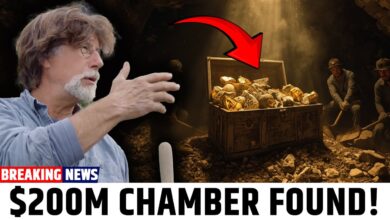CRITICAL CLUE to Money Pit Mystery The Curse of Oak Island Season 10
CRITICAL CLUE to Money Pit Mystery The Curse of Oak Island Season 10

Seems to be the flood tunnel system. Have you accidentally hit something that’s really validating to the history of Oak Island? Yeah, we’ve got science telling us that there’s a presence of a treasure here on the island, and then we’ve got an inadvertent kind of accidental hit that almost confirms the flood tunnel legend. Researchers discover a key clue to the enigma of The Money Pit.
It appears that the study team has at last discovered a clue to the treasure hidden in The Money Pit after spending many long and exhausting hours looking on Lot 13, which is situated just Northeast of the marsh. Rick Lagina, Tom Nolan, another landowner on Oak Island, and the other team members are getting ready to start another excavation. They are searching for significant proof.
Although clay was found, it was rather obvious that it wasn’t supposed to be there in the first place. They speculated that it might be blue clay of some sort when exploring an unusual rock formation known as the quadrilateral. Rick Lagina and the rest of the team recently discovered what may prove to be a crucial clue to The Money Pit mystery at a depth of 40ft.
Researchers started the first serious excavation of the ancient Money Pit in the year 1804. They found a layer of blue clay there at that depth, acting as a sealant to keep water out of the hole. Curiously, the researchers found the same substance in 2018 while looking at a ring-shaped stone monument called the Eye of the Swamp.
Is it conceivable that the crew has now found proof that the quadrilateral was made by the same people who altered the swamp and built the money pit? If that’s the case, it’s a really intriguing development. If that makes sense, it somewhat reminded them of what they had seen in The Money Pit.
Blue clay plays a significant role in the tale of The Money Pit’s discovery in history. If you were attempting to keep water out of some sort of underground structure, would you be able to make use of that? It’s possible that Rick Lagina’s theory, according to which the presence of blue clay points to the potential existence of a structure buried below, is true. If so, what kind of structure could it be, and could anything of outstanding value be inside?
The following morning, Rick Lagina and other crew members returned to Lot 13 so that geoscientists like Ian Spooner could look into the enigmatic quadrilateral feature that was providing a crucial clue to The Money Pit riddle. They felt that it was somewhat improbable that it could have spontaneously accumulated there. Additionally, they saw clay in a variety of colors, combined with pieces of burned wood. These two items in no way, shape, or form go together. One of the group members remarked that the clay appeared to be split up and misplaced.
There was an event that had a meaningful purpose and took place there. Truly, there must be a reason for everything that happened since the story is so complicated. There was one little spot that had gotten a little worse. There were striations all over the metal, marking that the thinness of the points gave the impression that they were made to be pushed into wood. Are you looking for a hand-forged iron staple or fastener?
Since the 6th century BC, large metal staples have been employed often in the construction of both stone and wooden structures. Could this manually formed metal fastener be another proof that a structure of some kind might be waiting to be revealed at the quadrilateral location? What kind of structure might it be in that situation, presuming the group has previously discovered blue clay?
Given that information, anything that took place prior to The Money Pit’s initial discovery has the potential to be considered original work. You will see that this so-called mainstay is actually rather puzzling when compared to the hard work that went into creating the great quadrilateral.
What, if any, contributions does this facet make to the larger mystery? As of yet, nothing has been decided on that. Carmen Leg, a specialist in blacksmithing, meets with Rick and Marty Lagina, Craig Tester, and archaeologist Emma Culligan at the Oak Island Interpretive Center to study the massive metal staple that was discovered the previous day.
Its starting point is a fantastic quadrilateral. Even though it was a strange geometric figure, they had no notion what the specific feature represented. They had found no others of its kind on the island before. There are now countless conjectures regarding the type of wealth that might be hidden on the island, as well as how it got there. However, the William Phips theory has won over a lot of supporters and is supported by a lot of data.
The theory was refuted by writer and history enthusiast Hamerson Peters in a recent video that was posted to his YouTube channel. The majority of the information presented in the movie is taken from the book Oak Island and its Lost Treasure, which first made the strong case for the conspiracy. Peters has proposed the following idea, which can be summed up as follows:
During the 17th century, William Phips was a skilled explorer, and the English supported him financially. The Protestant majority, including the political elite and aristocracy, developed a strong dislike for the Catholic King. When King James II came to power in 1685, James II adhered to Catholicism. Or, to put it another way, they planned to depose him.
The following stories are word-of-mouth legends from the late 18th century because there is so little information about the early treasure-related operations that occurred on Oak Island that has been objectively verified. It took many years after the incident before publishers began to pay attention to this kind of activity and look into the stories involved.
The tale of a treasure found by a settler named Daniel McGinnis was published for the first time in 1856. This is the story’s earliest known telling. After that, it was another 5 years before one of the purported original diggers gave a testimony regarding the initial narrative and subsequent Onslow and Truro company deeds.
The earliest settlers in the region heard tales of a dying crew member of Captain Kidd’s ship. The man said that Captain Kidd had hidden 2 million pounds worth of treasure on the island. Captain Kidd passed away in 1701, according to the most widely recognized version of the story. Daniel McGinnis came across a dip in the ground in 1799 while looking for a place to build a farm. McGinnis asked for help from other people in order to dig because he believed that the depression fit with the legend surrounding Captain Kidd.
With the aid of two people only known by the names John Smith and Anthony VA, he dug out the pit and found a layer of flagstones 2 feet (61 cm) below the surface. The earliest documents, however, merely mention marks of some sort at these intervals. Later accounts report finding oak platforms every 10 feet (3m). Although previous accounts only make reference to marks, the various legends also mentioned the tool marks or pick scratches on the hole’s walls.
The soil was not as well packed as the soil around it and it was visibly loose. The three men reportedly stopped their digging at a depth of 91.3 feet because of superstitious dread. In an alternative interpretation of the story, all four of the main characters are portrayed as teenagers. According to this account, McGinnis first learns of the slump in 1795 while on a fishing excursion. The rest of the story proceeds in the same manner as the first, with the logs discovered as its focal point, but it ends with the four people giving up after they have gone as far as they can.
For more current discovery stuff, remember to subscribe. They continue to excavate until they reached a depth of around 90 feet (27m), where they discovered layers of logs or marks spaced about 10 feet (3m) apart. They also discovered a large stone with symbols engraved onto it, as well as layers of charcoal, putty, and coconut fiber.
When the hole unexpectedly filled with water to a depth of 60 feet (18m), the situation for the diggers grew challenging. The alleged dig was finally given up on after repeated fruitless attempts by workers to retrieve the riches from below by excavating a tunnel starting at a second shaft that was equally flooded.
The most prosperous company of the pre-publication era is thought to have been the Truro Company, which is said to have been founded in 1849 by a group of investors. Reexcavation of the hole was placed all the way down to a level that was 26 and 86 feet below the surface, but it eventually overflowed once more. After that, it was decided to drill five boreholes into the machine’s original shaft using a pod auger.
Recently, scientists made what appears to be a weird discovery in space. Could this be an alien species? To learn more, click the next post.








